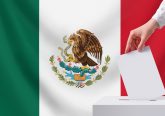Come Sunday at 6 p.m. (GMT-5) Mexican citizens will have had elected not only a new president, but also over 3,400 new public officials. Being the largest electoral process in Mexican history, this third federal voting round in the post-transition era determines not only Mexico’s future, but —along with several other elections in the region— it also helps configure the ideological composition of Latin America.
Instead of providing an overview of the contenders or discussing the trade-offs and the potential risks of the populist left, I will a) assess the campaign, b) zero in on the topics to look out for during and after election day and lastly, I will also c) identify key challenges for the future. My assumption or rather my concern is that, while it is interesting to talk about polls and effective vote intention, there are larger-than-victorissues that will heavily condition not only the consolidation, but ultimately the survivalof Mexican democracy.
Recounting the campaign’s toll…
Although the 2017 local elections served as a prelude for Mexican parties and media to shape up the political arena, formally, campaigns for the presidency started by the end of March and ended on the 27thof June, lasting 90 days exactly. While we could draw positive and negative highlights of speeches and collect sufficient material for a course on failed and effective political marketing, I would like to draw attention to two positive and two negative elements of the campaign experience:
The Good…
- Verificado 2018: In order to combat fake-news, a robust group of journalist teamed-up to verifythe veracity of statements made by candidates as well as the reliability of information circulated across social media platforms. Anyone, from candidates to voters, could ask for the support of the Verificado team via Facebook or Twitter. Fact-checking in (almost) real time definitely helped to up the quality of public debate and to dissipate or minimize the (alleged) influence of Russian intervention via misinformation. The effort made by Verificado—in a country less than amicable to journalism— warrants both, recognition and continuation.
- Presidential Debates: For the first time in Mexico’s democratic history, electoral authorities not only promoted debate among contenders but also formatted the encounters in a more flexible and dynamic fashion. With three debates between presidential candidates and a plethora of encounters among local nominees, Mexican voters not only had access to information but were also able to interact and become part of the political discussion. While there is still room for improvement, the changes introduced for this election were a step in the right direction.
Overall, the flow of information and the standards set to assess it, helped strengthen the transparency of the whole process. Having the electoral authority constantly tracking campaign expendituresand making them public was also vital to this purpose. These, along with the role played by Pedro Kumamoto and other independent candidatesto (local) Congress, are the key positive experiences of the 2018 campaign.
The Bad…
- Narco-politics: Like no other, the 2018 electoral process has been marred by drug-related violence and cartel influence, particularly at the state and municipal level. With over a 100 politicians murdered, the electoral process is a paradigmatic example of the institutional weakness of the Mexican State and of the vulnerability of its regime. Curtailing cartel influence and ensuring the security of newly elected officials are the set of minimal conditions for future governance.
- The Social Agenda: Although a recent study suggests that Mexico is more progressive than the United States, one of the disappointing aspects of the campaign is the fact that not a single candidate neither openly nor unapologetically supported abortion and the rights of the LGBTQ community. The lack of a clear social and environmental agenda is disturbing not only because it seems to run contra tempore, but most importantly, because these post-materialist concerns have been linked with the consolidation and the quality of democracy.
In sum, as the recent political use of judicial institutions also demonstrates, alleviating the heavily polarized environment in Mexico requires strengthening institutions and the rule of law as well as broadening the scope of the social topics and issues that articulate public discussions.
The (hopefully not so) Ugly: Election Day
On Sunday, polling stations open at 8 a.m. and close at 6 p.m. As citizens and party representatives count paper ballots, results start coming in around 8 p.m. and according to Mexico’s National Electoral Institute (INE), for the presidential race an irreversible trend will be detectable an hour before midnight. Below I pinpoint issues that will have gained salience as the night progresses:
- Violence and Fraud: Although sitting president Enrique Peña Nieto has guaranteed conditions for a peaceful election, police forces and citizens along with national and international observers need to shield the election against attempts to coerce voters via guns or fraud.
- Acknowledging the results: As soon as results start coming in, the reaction of the contenders will be critical in defining the public sentiment in the days to come. Although the front-runner is set to win by a landslide, recognizing the validity of the democratic process by acknowledging election results is critical for democracies and peaceful coexistence.
- Turnout and vote-share: Mexico’s record turnout occurred in 1994 when 77% of citizens voted. However, in spite of the magnitude of this election, abstention this year could be as high as 35%. The legitimacy of the newly elected government hinges, among other things, on the participation of the vast majority of the population. In addition, looking at vote-shares across branches and levels of government is relevant as they will be critical in configuring the political landscape in Mexico for at least the next three years. Lastly, it is important to highlight that young voters will be the ones redefining Mexico’s political geography.
Looking ahead…
This last section briefly looks at perhaps often-cited, but nonetheless crucial challenges that Mr. New Mexican President, but more broadly the Mexican State, will need to address in the short, mid and long term.
- Socio-economic challenge: Tackling violence and building up a secure and peaceful environment necessarily requires articulating a robust social and economic policy which addresses the longstanding levels of poverty and inequality. Strengthening LGBTQ rights, working conditions, wages, access to health and education services as well as de-politicizing —a.k.a deconstructing the clientelistic nature— of social programmes are some of the fundamental components shaping the socio-economic arena.
- Political Challenge: Beyond strengthening institutions and infrastructural capacity, the immediate demand (and the front-runner’s electoral promise) is to tackle corruption. Assuming that there are no surprises in the presidential results, it will be the first time in almost 8 decades that a left-of-centre candidate will occupy the executive office. The new president will have to successfully bargain and accommodate political interests from outside and within his clique in order to guarantee a peaceful transfer of power, an effective governance and efficacy in policy implementation.
- International challenge: This election took place amidst uncertainty for the future of NAFTA. Mexico’s new government will have to face the Trump administration and navigate its apparent convoluted and non-conventional nature. In this regard, diversification is key. Turning heads to Europe, Asia and South America will be critical for Mexican industrial and financial trade.
This election has the potential to completely reshuffle the cards and change the distribution of power across the country. In an international scenario in which democracy seems under threat, Mexico’s new government needs to show that we can achieve growth with equity. In the upcoming years Mexico needs to convey a clear message to the world: there is still hope.




